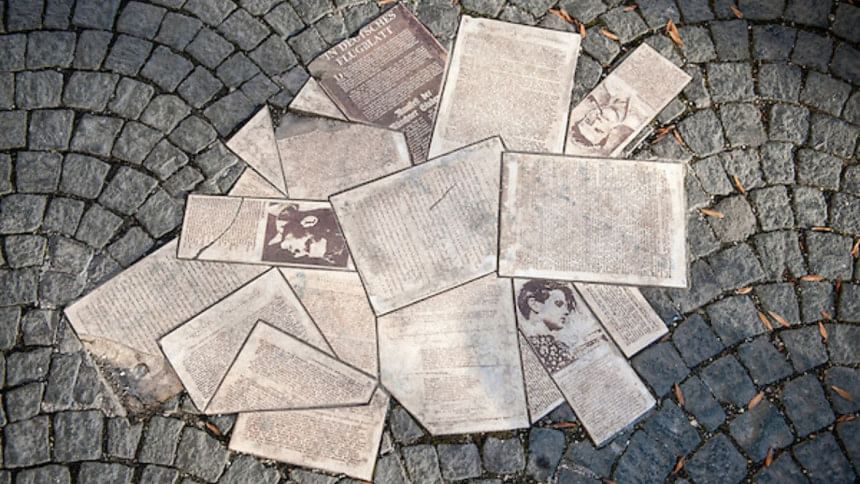Tyranny doesn't go unanswered

WHER-EVER autocracy exists resistance does too. History teaches us that. February 23 is a day that is remembered in Germany for events that took place at the height of Nazi power in a place called Munich. A few brave men and women belonging to the University of Munich decided to warn the German public of the dangers posed by Hitler and his cohorts. They were led by a Philosophy professor named Kurt Huber and theirs was a non-violent movement that came to be known as 'Weiße Rose' or 'White Rose,' and this is their story.
The 'White Rose' was an intellectual resistance group that led a non-violent propaganda movement against Hitler's regime. Given the stranglehold of the state security apparatus (Gestapo) over Germany at the time it is not surprising that this effort lasted less than a year. Their 'resistance' consisted of spreading leaflets and writing graffiti on walls. That the group published material under the banner "Manifesto of the Students of Munich" meant that their discovery and doom were inevitable. All six members were arrested by the Gestapo, tried and for treason and beheaded in 1943. While branded as traitors then, today they are revered as heroes. Not because they led a movement that had zero of chance of success, rather that they decided to stand up for their beliefs knowing full well what the outcome of their actions would entail.
The only survivor of the group, Jürgen Wittenstein, painted a bleak picture of Germany at the time "The government -- or rather, the party -- controlled everything: the news media, arms, police, the armed forces, the judiciary system, communications, travel, all levels of education from kindergarten to universities, all cultural and religious institutions. Political indoctrination started at a very early age, and continued by means of the Hitler Youth with the ultimate goal of complete mind control. Children were exhorted in school to denounce even their own parents for derogatory remarks about Hitler or Nazi ideology."
It is in this setting that the group set about to make history. Given that secrecy was of paramount importance and spies could be found ten-a-penny, work was painfully slow and the group distributed a total of six leaflets. The message was one that called for opposition to Nazi oppression and tyranny. That the group managed to work and distribute its leaflets for eight months under the most tyrannical regime of the 20th century is itself a record. The supreme sacrifice we write about in our writings about fallen heroes applies to these brave few.
Most members of this small group were in their twenties and yet they decided to brave the insurmountable odds. This was a diverse group of people, with different upbringings. There were both Catholics and Lutherans. Some of the White Rose members had served on the Russian front and witnessed the horrors of war. The mass execution of Jews, the wholesale torture of "conquered" people in East Europe -- all helped shape these individuals' actions later on.
Their rejection of national socialistic ideals, fascism in all its manifestations led them to propagate a message of peace with the hope that one day a society could be established on the principles of tolerance and justice. It is interesting that the year 1943 was chosen when the White Rose would make its presence known. By that time the blitzkrieg had lost some of its sheen. The quick victories were grinding to a halt in the East. The battle of Stalingrad is where German steel was checked by Russian patriotism and the seemingly unstoppable German war machine had come to a full stop. It is also the year when the "final solution" was gathering steam. News was filtering home about excesses committed by Nazis in foreign lands against civilians which had the seal of approval from Berlin. The fact that this was state policy and hundreds of thousands of people could be slaughtered for belonging to an "inferior" race or simply because the State believed their existence was no longer necessary was an unacceptable situation to the members of the White Rose; from a moral and ethical point of view.
Given the paucity of resources, leaflets produced by the White Rose did not get printed in hundreds of thousands. Their distribution was primarily done among universities since members were mostly students. Later, they started to appear in many cities including Cologne, Hamburg, Berlin, Stuttgart to name but a few. The leaflets were accompanied by sudden appearance of graffiti on walls in Munich.
It is hardly a wonder that the government went after the White Rose with vengeance and executed them in a fashion that would convey a message to other would-be trouble makers. It is interesting to note that the White Rose's final leaflet used by the Allies was produced in millions and air-dropped all over Germany. Today, the members of the White Rose are branded as patriots and heroes in their native land, ironically, by both halves of partitioned Germany after World War 2 and by reunified Germany later on. Their actions have inspired movements and ideas beyond the borders of Germany. To quote from one of their leaflets: We will not be silent. We are your bad conscience. The White Rose will not leave you in peace!
The writer is Assistant Editor, The Daily Star.

 For all latest news, follow The Daily Star's Google News channel.
For all latest news, follow The Daily Star's Google News channel. 



Comments